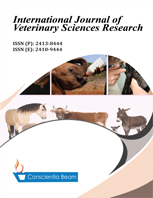Microscopic Detection of Haemoparasites in Muscovy Ducks (Anas Platyrynchos) in Gombe State, Nigeria
DOI:
https://doi.org/10.18488/journal.110.2019.52.23.31Abstract
This present study aimed to detect haemosporidians from the blood of Muscovy ducks in Gombe State Nigeria. Blood samples were collected from 880 apparently healthy ducks of both sexes from the month of April, 2015 to February, 2016. Microscopic examination of Giemsa stained thin blood films revealed 16.14% overall prevalent rate of haemoparasites. The prevalence was found to be highest in Yamaltu/Deba LGA (23.08%) and least in Funakaye LGA (7.83%). Among the four genera of haemoparasites detected, Aegyptinella species (7.73%) was most prevalent followed by Leucocytozoon species (5.57%) and Haemoproteus species (2.16%) while Plasmodium specie (0.68%) was the least. Prevalence rate was found to be significantly higher (p<0.0001) in the young (22.68%) compared to the adults (10.43%) ducks. The female (18.54%) were found to be more infected than the male (13.58%) ducks, but the difference was not statistically significant (p = 0.0565). The prevalence of haemoparasites was found to be significantly (p<0.0001) higher during the rainy (24.55%) compared to the dry (7.27%) season. This present study represents the first to provide evidence of haemoparasites in Muscovy ducks in Gombe State, Nigeria. There is need for further researches on the epidemiology of haemoparasites in Muscovy ducks reared under extensive management system in Nigeria. Strategic control of arthropods and maintenance of strict biosecurity in and around poultry houses will curb transmission of arthropod borne haemoparasites among village poultry species.

